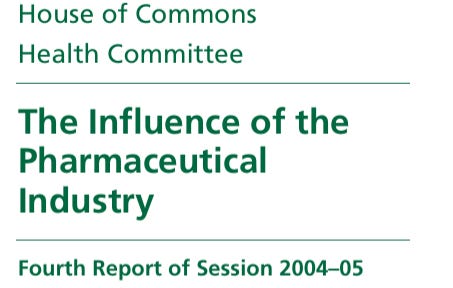|
 |
By the early 2000s, the UK recognised that pharma had too much influence over medical research, clinical trials, drug regulation (especially the MHRA), and doctors’ prescribing behaviour.
There was a sense that commercial interests were eclipsing patient interests — particularly as several “blockbuster” drugs dominated markets and research priorities were distorted by profits rather than public health needs.
Consequently, in 2005, the House of Commons Health Committee reported on “The Influence of the Pharmaceutical Industry”. The first major parliamentary scrutiny of the pharmaceutical industry in the UK since 1914.
The Committee found that pharma’s influence “permeates the health service, regulatory and licensing bodies, research institutions, Government and the public perception of medicines.”
The industry had a major effect on what research is done, how it is designed, reported and interpreted. Allegations arose that clinical trials were poorly designed to favour new drugs, often misrepresenting their actual effects on patient health outcomes. The committee learned of several notable instances of trial result suppression, selective publication, and ghostwriting.
The committee noted “there has been a trend towards categorising more and more individuals as ‘abnormal’ or in need of drug treatment.” And a strong proportion of “me-too” drugs were being developed rather than genuinely novel therapies.
MPs received evidence of heavy marketing to prescribers, including free gifts, hospitality, and sponsored events, biased educational materials, and funding for patient organisations and medical charities.
The concerns extended to medical journals, which were found to be heavily influenced by pharma: “It is alleged that too many articles do not present an objective assessment of the merits of a medicine.”
The committee was particularly scathing about the MHRA. Post-marketing surveillance was judged to have significant weaknesses, including insufficient transparency regarding the data used for licensing and inadequate public access to relevant material. The Committee raised the need for improved monitoring of adverse reactions, greater independence in regulatory processes, and greater patient involvement.
The inquiry was the first for a hundred years to reflect on how far modern medicine had become dependent on — and shaped by — commercial drug companies; the report’s tone was highly critical of the status quo, suggesting that industry influence was insufficiently aligned with patient and public health interests.
Given the conclusions, you’d have thought that major changes were afoot.
“Today the industry has got a very bad name. That is very unfortunate for an industry that we should look up to and believe in, and that we should be supporting. I think there have to be some big changes.”
After the UK left the EU, the regulatory landscape for pharma changed significantly. The MHRA gained autonomy to approve clinical trials and medicines, aiming to make the UK more competitive in life sciences, and the government adopted a pro-pharma stance, pursuing an “innovation-first” regulatory agenda.
Industry’s interests increasingly trump an evidence-first approach; not only do the 2005 report’s concerns persist, but pharma has expanded its influence on the research agenda, the regulator and NHS decision-making, skewing priorities away from public needs. The awakening presented in the 2005 House of Commons report regarding the influence of the pharmaceutical industry has been overlooked, as the UK government continues to adopt a pro-pharma stance that prioritises industry interests over public health concerns.
This post was written by two old geezers who seem to slumber but, in their dotage, are suddenly jolted awake by the alarm bells of experience.
Up next - Part 4: The Pressure Groups
You're currently a free subscriber to Trust the Evidence. For the full experience, upgrade your subscription.
